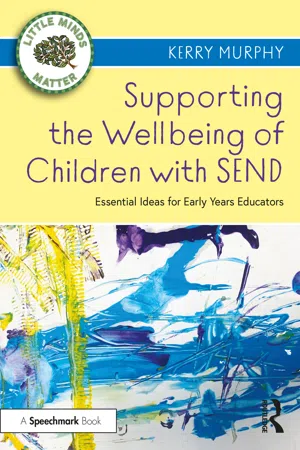
Supporting the Wellbeing of Children with SEND
Essential Ideas for Early Years Educators
- 220 pages
- English
- ePUB (mobile friendly)
- Available on iOS & Android
Supporting the Wellbeing of Children with SEND
Essential Ideas for Early Years Educators
About this book
As an early years practitioner, you will educate and care for children with a range of developmental needs and differences. This essential book introduces you to a play-rich approach providing both universal and targeted ideas that will support social and emotional development and ensure that children feel safe, secure, and nurtured.
Using the four broad areas of need as a guide, each accessible chapter positions wellbeing at the heart of an effective approach to inclusion and offers meaningful and responsive teaching practices that create a sense of belonging and acceptance. Founded in the latest research, the book presents key knowledge alongside ideas and activities to support wellbeing, which can be embedded into the child's everyday experiences and adapted to meet their individual needs.
This book offers:
- Evidence-based strategies and techniques that have a positive impact on the long-term social and emotional wellbeing of children with SEND.
- Guidance through the four broad areas of need, with a focus on play, learning, and developing an emotionally healthy early years environment.
- Examples of practice in action.
- Case studies, reflective questions, and activities that will upskill the reader and empower them in their role.
Providing up to date, transferrable and essential knowledge on SEND in the early years, this is an essential resource for any practitioner looking to expand their repertoire and enrich the wellbeing of children with SEND.
Frequently asked questions
- Essential is ideal for learners and professionals who enjoy exploring a wide range of subjects. Access the Essential Library with 800,000+ trusted titles and best-sellers across business, personal growth, and the humanities. Includes unlimited reading time and Standard Read Aloud voice.
- Complete: Perfect for advanced learners and researchers needing full, unrestricted access. Unlock 1.4M+ books across hundreds of subjects, including academic and specialized titles. The Complete Plan also includes advanced features like Premium Read Aloud and Research Assistant.
Please note we cannot support devices running on iOS 13 and Android 7 or earlier. Learn more about using the app.
Information
1 Introducing wellbeing and SEND
Starting points
- What are your thoughts on mental health terminology?
- Do you feel comfortable talking about the different components of mental health, including social and emotional wellbeing?
- Why do you think it is vital to establish a shared consensus on the language of mental health and wellbeing?
Introduction
- Reflections and activities

There are individual and collective points in which you can consider your current practice and areas of development. These would be useful in team meetings or virtual CPD sessions. - Research snippets and “Did you know?”

There are lots of examples of research for you to consider when developing your approach to wellbeing. It is important to remember that our understanding and evidence-base evolves, so “hold your knowledge lightly” and be open to adaptations in practice as we come to understand more about SEND and wellbeing. There are also “Did you know?” boxes that challenge some of our current perceptions around SEND. - Wellbeing strategies and strategies to avoid

Throughout the book, you will see lots of evidence-based and anecdotal strategies. You must think about these in the context of children’s everyday experiences and play. There are also strategies to avoid due to being ineffective, controversial or harmful to wellbeing and mental health. - Case studies and “voice”

The chapter includes examples of real case studies that will help you develop your practice and children’s, families and professionals’ “voices” because all perspectives count. - Read, watch and listen

At the end of each chapter, you will find signposts to other resources for your professional development. These signposts will help you to strengthen your practice. - The wellbeing scales

Also included in the book is the scales symbol. This will be a moment for you to reflect on the risk and protective factors that can tip the wellbeing scales. We will discuss these in more detail across this chapter.
Defining SEND and inclusion in the early years

- A child or young person has SEN if they have a learning difficulty or disability, which calls for special educational provisions to be made for him or her.
- A child of compulsory school age or a young person has a learning difficulty or disability if he or she:
- has significantly greater difficulty in learning than the majority of others of the same age, or
- has a disability that prevents or hinders him or her from making use of facilities of a kind generally provided for others of the same age in mainstream schools or mainstream post-16 institutions
Is the term SEND fit for purpose?
thinking about some children as part of a special group who have particular n...
Table of contents
- Cover
- Half-Title
- Series
- Title
- Copyright
- Contents
- Foreword
- Preface
- Language and terminology
- 1 Introducing wellbeing and SEND
- 2 Educator wellbeing in SEND support
- 3 Social, emotional and/or mental health
- 4 Physical and sensory needs
- 5 Speech, language and communication needs
- 6 Cognition and learning needs
- 7 Empowerment and collaboration with parents
- 8 Transition and wellbeing
- Concluding remarks and a word on advocacy
- Answers
- References
- Index